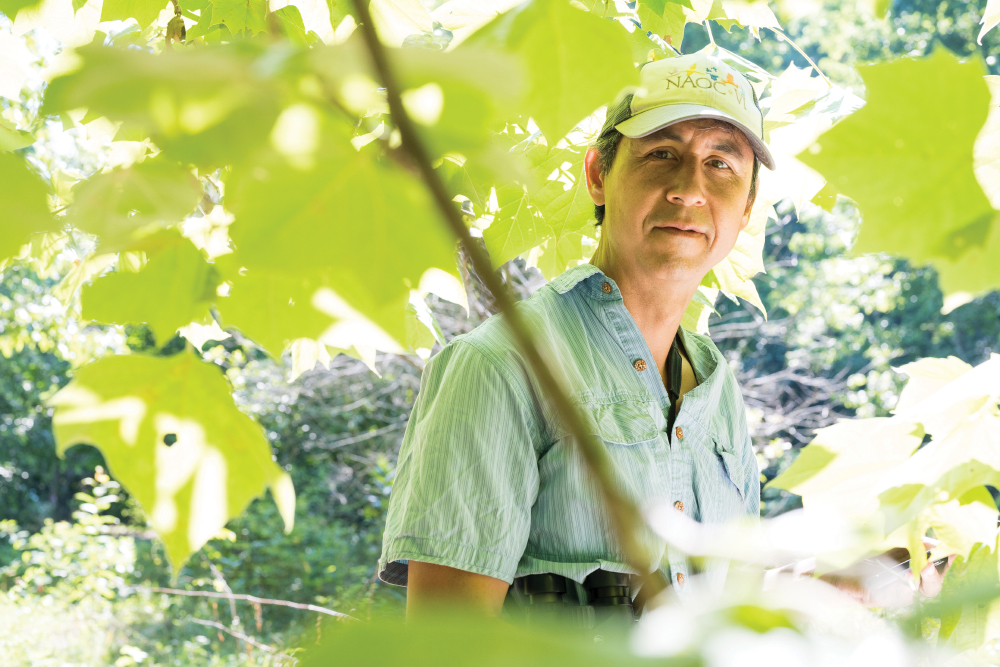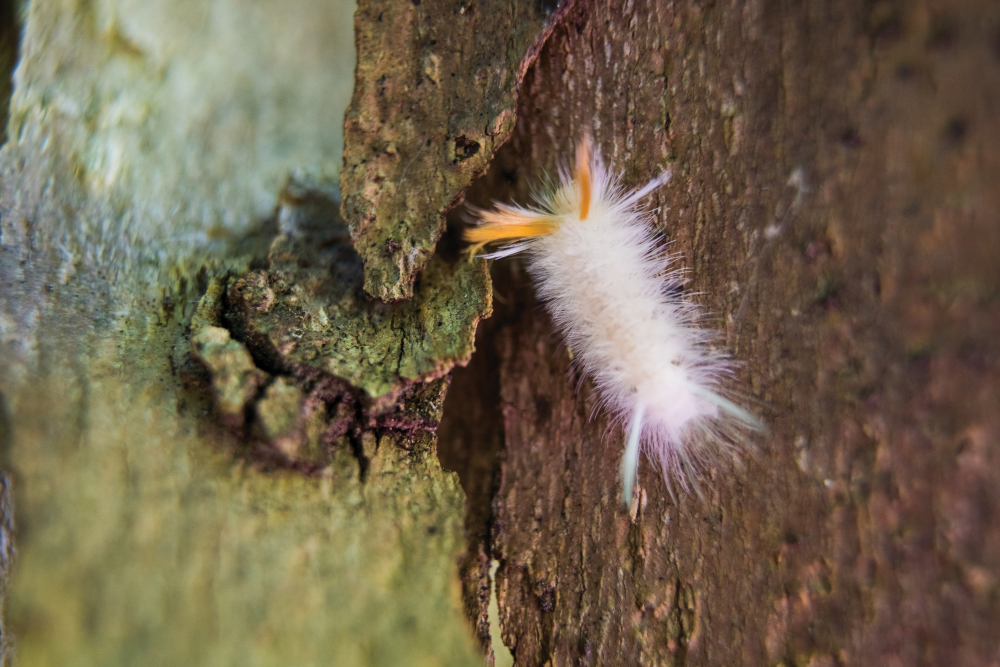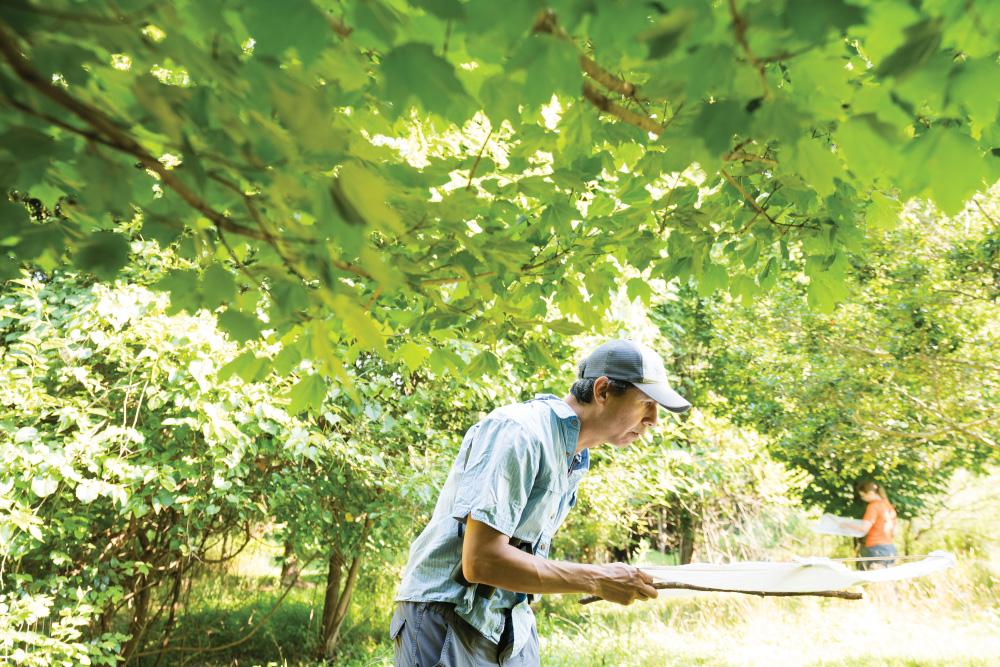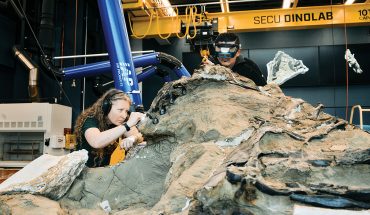Through this ongoing program, kids, teens, and nature enthusiasts are able to contribute to the ongoing study of bugs and birds.
by Hampton Williams Hoffer / photography by Justin Kase Conder

Head to the Prairie Ridge Ecostation, and you may see an odd practice: somebody whacking a tree limb with a stick, collecting what drops onto a white sheet below. It is not, in fact, an adult throwing a tantrum, but rather a participant in the Caterpillars Count! program at the North Carolina Museum of Natural Sciences.
Caterpillars Count! was launched in 2014 by Allen Hurlbert, a professor of biology at the University of North Carolina at Chapel Hill. The program welcomes citizen scientists — regular people who need little to no experience or equipment — to download a free app, follow some simple directions, and contribute to an ever-growing collection of data by examining trees to see which insects end up on those white sheets and when. With the help of volunteer naturalists, researchers are better understanding the life patterns of foliage insects called arthropods — which include caterpillars, beetles, spiders, and leafhoppers — that provide essential food for nesting birds.
It’s a massive team effort, and it all started here, at the outdoor nature center. Prairie Ridge Ecostation boasts 45 acres of Piedmont prairie, forest, ponds, and streams near Edwards Mill Road. “Prairie Ridge is an ideal location for engaging the public in the wonders of the natural world,” says Hurlbert. Once a cow pasture, the area offers a vast array of habitats. As long ago as 1540, explorers wrote of “savannas” in the Carolina Piedmont: large open spaces, covered in grasses and low-lying plants, with few trees. Piedmont prairies never grew as expansive as those in the Midwest due to the rivers and streams that provided firebreaks, but those same rivers and streams add to the variety that makes the ecostation a naturalist’s dream. Prairie Ridge was the project’s flagship location, and now more than 100 other survey sites span across North America, from south Georgia
to Canada.
Within the Caterpillars Count! effort, every find — each tent caterpillar or geometer moth recorded on the leaf of a sugar maple — is a piece in revealing answers to questions about arthropods. Insect decline is certainly a concern, but so is insect abundance. Here’s why it matters: with climate change, the naturally shifting seasonal peaks — the times where there are the most of one insect or another — can become out of sync with the needs of nesting birds. “Migratory birds that winter in Central or South America may be especially sensitive to this type of timing mismatch,” Hurlbert explains, “as they may be less aware of the extent to which springs in North Carolina are advancing earlier than normal.”
Caterpillars Count! is not the only citizen science project rolling at the NCMNS. This month, to coincide with their annual BugFest, the museum is calling on citizen scientists to help find, and thus protect, the endangered Rusty Patched Bumblebee. It’s an endearing, fuzzy little pollinator, the ideal poster child for endangered insects. “Citizen science is a way that anyone can get involved in scientific research,” says Christine Goforth, head of citizen science at the NCMNS. “You never know when a simple observation you make might lead to a major discovery.”
She points out that amateur naturalists often — and sometimes unknowingly — contribute to significant discoveries. In 2019, for example, a participant in an NCMNS project called City Nature Challenge took a photo of a random plant, simply because it was one she hadn’t seen before. It turned out to be the rare and endangered veined skullcap, a flowering plant that had not been spotted in Wake County for 60 years. Scientists immediately began conservation efforts at the site where it was found.
For six years, Rebecca Ward has volunteered as a citizen scientist on various NCMNS projects: “Participating in Caterpillars Count! definitely opened my eyes to just how much is going on in trees. I would sometimes go slowly through collecting because I’d be pulling out my phone taking pictures of what we found and trying to identify them on iNaturalist or other apps.” Ward, who works as a climatologist in the State Climate Office of North Carolina, is a self-proclaimed science geek with an affinity for the outdoors. “Being a citizen scientist lets me join both of those passions,” she says, “while also contributing to something larger than myself.”
A remarkable 290 unique species of insects have been identified through photos submitted to the Caterpillars Count! project so far. Some aren’t even from around here. “We’ve realized that the most common ladybird beetle — as in, ladybug — found in this area is actually not native,” says Hurlbert. Last month, a site in South Carolina found a spider that experts did not recognize. “The closest identification they could come to is a spider only known in New Zealand, the white-banded orb weaver,” says Hurlbert. With so many hands on deck for this collective project, thousands of insect entries comprise the Caterpillars Count! data, which is freely available for anyone to explore on the museum’s website.
Over just a few sultry June days, participants recorded firefly beetles, Batman moths, coppery leafhoppers, and crab spiders on the leaves of Raleigh’s trees.“When you slow down and pay close attention to the leaves and branches around you, you realize the tremendous biodiversity surrounding all of us,” says Hurlbert.
__
This article originally appeared in the September 2021 issue of WALTER magazine.






